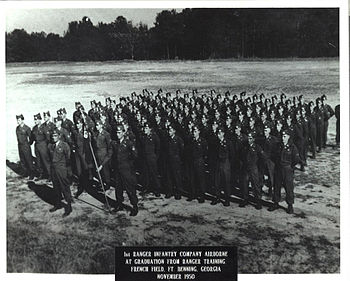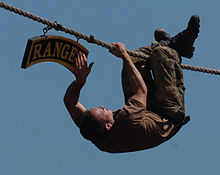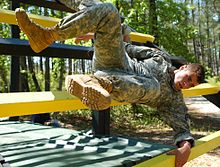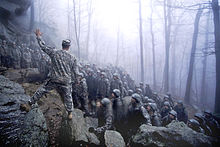- Ranger School
-
The United States Army Ranger School is an intense 61-day combat leadership course oriented towards small-unit tactics. It has been called the "toughest combat course in the world"[1] and "is the most physically and mentally demanding leadership school the Army has to offer".[2] The course is conducted in various locations. Training in the Benning Phase occurs in and around Camp Rogers and Camp Darby at Fort Benning, Georgia. Training at the Mountain Phase is conducted at Camp Merrill, in the remote mountains near Dahlonega Georgia. The Florida Phase is conducted at various locations near Camp Rudder, Eglin Air Force Base, Florida. The Desert Phase—conducted initially at the White Sands Missile Range in New Mexico, and later relocated to Dugway Proving Ground, Utah and Fort Bliss, Texas—was eliminated in 1995. Ranger School is effectively closed to female applicants due to the Combat Exclusion Laws pertaining to assignment to Ranger-coded positions within the Combat Arms of the United States armed forces.
The United States Army Ranger School is not organizationally affiliated with the 75th Ranger Regiment. Ranger School falls under control of the United States Army Training and Doctrine Command as a school open to most male members of the United States Army; while the 75th Ranger Regiment is a Special Operations warfighting unit organized under the United States Army Special Operations Command. The two share a common heritage and subordinate battalions common lineage, and Ranger School is a requirement for all officers and NCOs of the 75th Ranger Regiment.
Contents
History
Ranger Training began in September 1950 at Fort Benning Georgia "with the formation and training of 17 Airborne Companies by the Ranger Training Command".[3] The first class graduated from Ranger training in November 1950.[4] The United States Army's Infantry School officially established the Ranger Department in December 1951. Under the Ranger Department, the first Ranger School Class was conducted in January–March 1952, with a graduation date of 1 March 1952. Its duration was 59 days.[5] At the time, Ranger training was voluntary.
In 1966, a panel headed by General Ralph E. Haines Jr. recommended making Ranger training mandatory for all Regular Army officers upon commissioning. "On 16 August 1966, the Chief of Staff of the Army, General Harold K. Johnson, directed it so." This policy was implemented in July of 1967. It was rescinded on 21 June 1972 by General William Westmoreland. Once again, Ranger training was voluntary.[5]
In August 1987, the Ranger Department was split from the Infantry School and the Ranger Training Brigade was established. The Ranger Companies that made up the Ranger Department became the current training units—the 4th, 5th and 6th Ranger Training Battalions.[6]
In 1983, the Desert Phase was added and the length of the Ranger course was extended to 65 days. The duration was again expanded in October 1991 to 68 days, concurrently with the reshuffling of the Desert phase from the last phase to the second. The 7th Ranger Training Battalion was added to administer this phase. The most recent duration change to Ranger School occurred in May 1995, when the Desert Phase was removed from the Ranger course. Ranger School was reduced to its current length—61 days of training, at 19.6 hours of training per day.[6]
The Ranger Assessment Phase, the first five days of Ranger School, was added in the first class of 1992.[7]
Students
Ranger School is open to all Military Occupational Specialties (MOSs) in the US Army, although—as of April 2011—an Army combat exclusion zone still limits some from attending.[8] Ranger students come from units in the US Army, US Marine Corps, US Air Force, US Navy, US Coast Guard, and from foreign military services. However, the two largest "customers" for Ranger School are the US Army's Infantry Basic Officer Leadership Course (IBOLC), and the 75th Ranger Regiment.[8] Ranger School slots are highly valued school slots. Competitions and pre-Ranger courses are typically used to determine attendance.
Ranger students' ranks typically range from Private First Class to Captain, with lieutenants and specialists making up the largest group of students. The average age is 23, and the average class will have 366 students, with 11 classes conducted per year.[8]
Training
Not for the weak or fainthearted.
Ranger School training has a basic scenario: the flourishing drug and terrorist operations of the enemy forces, the "Aragon Liberation Front," must be stopped. To do so, the Rangers will take the fight to their territory, the rough terrain surrounding Fort Benning, the mountains of northern Georgia, and the swamps and coast of Florida. Ranger students are given a clear mission, but they determine how to best execute it.
The purpose of the course is learning to soldier as a combat leader while enduring the great mental and psychological stresses and physical fatigue of combat; the Ranger Instructors (RIs) create and cultivate such a physical and mental environment. The course primarily comprises field craft instruction; students plan and execute daily patrolling, perform reconnaissance, ambushes, and raids against dispersed targets, followed by stealthy movement to a new patrol base to plan the next mission. Ranger students conduct about 20 hours of training per day, while consuming two or fewer meals daily totaling about 2,200 calories (9,200 kJ), with an average of 3.5 hours of sleep a day. Students sleep more before a parachute jump for safety considerations. Ranger students typically wear and carry some 65–90 pounds (29–41 kg) of weapons, equipment, and training ammunition while patrolling more than 200 miles (320 km) throughout the course.[8]
Capabilities
Ranger School students will participate in three airborne, and several air assault operations throughout the duration of the course, relying on C-130 Hercules cargo planes, as well as UH-60 Black Hawk and CH-47 Chinook helicopters, for insertion and extraction. Non-airborne personnel will work drop zone details while the other students jump. The students also have the ability to call-in and utilize close air support in the form of AH-64 Apache attack helicopters and AC-130H Spectre gunships during many of their missions. All aircraft are provided by other nearby units as part of a training co-operative.
Benning Phase
The first phase of Ranger School is conducted at Camp Rogers and Camp Darby at Fort Benning, Georgia and is conducted by the 4th Ranger Training Battalion. The "Benning Phase" is the "crawl" phase of Ranger School, where students learn the fundamentals of squad-level mission planning. It is "designed to assess a Soldier’s physical stamina, mental toughness, leadership abilities, and establishes the tactical fundamentals required for follow-on phases of Ranger School".[10] In this phase, training is separated into two parts, the Ranger Assessment Phase (RAP) and Squad Combat Operations.
The Ranger Assessment Phase is conducted at Camp Rogers. As of April 2011, it encompases Days 1–3 of training. Historically, it accounts for 60% of students who fail to graduate Ranger School.[8] Events include:
- Ranger Physical Fitness Test (RPFT) requiring the following minimums:
-
- Push-ups: 49 (in 2 minutes, graded strictly for perfect form)
- Sit-ups: 59 (in 2 minutes)
- Chin-ups: 6 (performed from a dead hang with no lower body movement)
- 5 mile individual run in 40 minutes or less over a course with gently rolling terrain
- Combat Water Survival Test (no longer conducted as of 2010)
- Combat Water Survival Assessment, conducted at Victory Pond (previously called the Water Confidence Test). This test consists of three events that test the Ranger student's ability to calmly overcome any fear of heights or water. Students must calmly walk across a log suspended thirty-five feet above the pond, then transition to a rope crawl before plunging into the water. Each student must then jump into the pond and ditch their rifle and load-bearing equipment while submerged. Finally, each student climbs a ladder to the top of a seventy foot tower and traverses down to the water on a pulley attached to a suspended cable, subsequently plunging into the pond. All of these tasks must be performed calmly without any type of safety harness. If a student fails to negotiate an obstacle (through fear, hesitation or by not completing it correctly) he is dropped from the course.
- Combination Night/Day land navigation test - This has proven to be one of the more difficult events for students, as sending units fail to teach land navigation using a map and compass. Students are given a predetermined number of MGRS locations and begin testing approximately two hours prior to dawn. Flashlights, with red lens filters, may only be used for map referencing; the use of flashlight to navigate across terrain will result in an immediate dismissal from the school. Later in the course, Ranger students will be expected to conduct, and navigate, patrols at night without violating light discipline. The land navigation test instills this skill early in each student's mind, thus making the task second nature when graded patrolling begins.
- A 3-mile terrain run, followed by the Malvesti Field Obstacle Course, featuring the notorious "worm pit": a shallow, muddy, 25-meter obstacle covered by knee-high barbed wire. The obstacle must be negotiated—usually several times—on one's back and belly.
- Demolitions training and airborne refresher training.
- Modern Army Combatives Program (MACP) training was removed as a part of a new POI at the start of 2009; however, it was reinstated with Class 06-10. The Combatives Program now is spread over all phases and culminates with practical application in Florida Phase.
- A 15-mile forced, tactical ruck march with full gear from Camp Rogers to Camp Darby. This is the last test during RAP and is a pass/fail event. If the Ranger student fails to maintain the pace set by the Ranger Instructors, he is dropped from the course.
The emphasis at Camp Darby is on the instruction in and execution of Squad Combat Operations. The phase includes "fast paced instruction on troop leading procedures, principles of patrolling, demolitions, field craft, and basic battle drills focused towards squad ambush and reconnaissance missions".[10] The Ranger student receives instruction on airborne/air assault operations, demolitions, environmental and "field craft" training, executes the infamous "Darby Queen" obstacle course, and learns the fundamentals of patrolling, warning and operations orders, and communications. The fundamentals of combat operations include battle drills (React to Contact, Break Contact, React to Ambush, Platoon Raid), which are focused on providing the principles and techniques that enable the squad-level element to successfully conduct reconnaissance and raid missions. As a result, the Ranger student gains tactical and technical proficiency, confidence in himself, and prepares to move to the next phase of the course, the Mountain Phase.
Mountain Phase
The second phase of Ranger School is conducted at the remote Camp Merrill near Dahlonega, Georgia by the 5th Ranger Training Battalion. Here, "students receive instruction on military mountaineering tasks, mobility training, as well as techniques for employing a platoon for continuous combat patrol operations in a mountainous environment".[10] Adding to the physical hardships endured in the Benning phase, in this phase "the stamina and commitment of the Ranger student is stressed to the maximum. At any time, he may be selected to lead tired, hungry, physically expended students to accomplish yet another combat patrol mission".[10] One of the mental hardships (asside from the pressures of training) is that the Mountain Phase is located 'in the middle of nowhere', several miles from any real civilization. This leaves the students feeling more isolated than they may feel during the other phases. In the winter, the temperatures drop very low at night, and many students (in addition to other ailments) receive frostbite. During the warmer months, Poison Ivy becomes a common adversary. The Ranger student continues learning how to sustain himself and his subordinates in the mountains. The rugged terrain, severe weather, hunger, mental and physical fatigue, and the psychological stress the student encounters allow him to measure his capabilities and limitations and those of his fellow soldiers.
In addition to combat operations, the student receives four days of military mountaineering training. The sequence of training has changed in past decades. As of 2010, the training sequence is as follows. In the first two days students learn knots, belays, anchor points, rope management, mobility evacuation, and the fundamentals of climbing and abseiling. The training ends in a two-day Upper mountaineering exercise at Yonah Mountain, to apply the skills learned during Lower mountaineering. Each student must make all prescribed climbs at Mt. Yonah to continue in the course. During the field training exercise (FTX), students execute a mission requiring mountaineering skills.
Combat missions are against a conventionally-equipped threat force in a Mid-Intensity Conflict. These missions are both day and night in a two part, four and five day FTX, and include moving cross country over mountains, vehicle ambushes, raiding communications and mortar sites, river crossing, and scaling steeply-sloped mountainous terrain.
The Ranger student reaches his objective in several ways: cross-country movement, parachuting into small drop zones, air assaults into small, mountain-side landing zones, or a 10-mile march across the Tennessee Valley Divide. The student's commitment and physico-mental stamina are tested to the maximum. At the end of the Mountain Phase, the students travel by bus to a nearby airfield and conduct an airborne operation, parachuting into Florida Phase. Non-airborne are bussed to Eglin Air Force Base for the Florida Phase.
Florida Phase
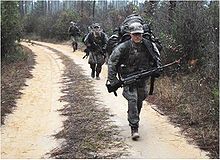 Ranger students in their final week of U.S. Army Ranger School, travel a short distance on a dirt path before veering back into the forested swampland of Auxiliary Field Six at Eglin Air Force Base, Fla. December 7, 2009.
Ranger students in their final week of U.S. Army Ranger School, travel a short distance on a dirt path before veering back into the forested swampland of Auxiliary Field Six at Eglin Air Force Base, Fla. December 7, 2009.
The third phase of Ranger School is conducted at Camp James E. Rudder (Auxiliary Field #6), Eglin Air Force Base, Florida by the 6th Ranger Training Battalion. According to the Ranger Training Brigade,
This phase focuses on the continued development of the Ranger Student's combat arms functional skills. Students receive instruction on waterborne operations, small boat movements, and stream crossings upon arrival. Practical exercises in extended platoon level operations executed in a coastal swamp environment test the Students’ ability to operate effectively under conditions of extreme mental and physical stress. This training further develops the Students' ability to plan and lead small units during independent and coordinated airborne, air assault, small boat, and dismounted combat patrol operations in a low intensity combat environment against a well trained, sophisticated enemy.[10]
The Florida Phase continues the progressive, realistic OPFOR (opposing forces) scenario. As the scenario develops, the students receive "in-country" technique training that assists them in accomplishing the tactical missions later in the phase. Technique training includes: small boat operations, expedient stream crossing techniques, and skills needed to survive and operate in a rainforest/swamp environment by learning how to deal with reptiles and how to determine the difference between venomous snakes and non-venomous snakes. Camp Rudder has specially trained reptile experts that teach the students to not fear the wildlife they encounter.
The Ranger students are updated on the scenario that eventually commits the unit to combat during techniques training. The 10-day FTX comprises "fast paced, highly stressful, challenging exercises in which the Students are evaluated on their ability to apply small unit tactics and techniques during the execution of raids, ambushes, movements to contact, and urban assaults to accomplish their assigned missions".[10] The capstone of the course is the extensively-planned raid of the ALF's island stronghold. This small boat operation involves each platoon in the class, all working together on separate missions to take down the cartel's final point of strength.
Afterwards, students who have met graduation requirements spend several days cleaning their weapons and equipment before returning to Fort Benning. By then they have earned PX (Post Exchange) privileges, and access to a community center where they can use a telephone, eat civilian food, and watch television. In years past, the "Gator Lounge" served this purpose, but it was destroyed by a fire in late 2006. Graduation is at Fort Benning. In an elaborate ceremony at Victory Pond, the black-and-gold Ranger Tab is pinned to the graduating soldier's left shoulder (usually by a relative, a respected RI, or soldier from the student's original unit). The Ranger Tab is permanently worn above the soldier's unit patch.
Desert Phase
The Desert Phase was designed to instruct its students in Desert Warfare operations and basic survival in the deserts of the Middle East. John Lock describes the Desert Phase as follows.
The phase commenced with an in-flight rigging and airborne assault—or an air assault landing by non airborne personnel, onto an objective. Following the mission, the students moved into a cantonment area. Remaining in garrison for five days, they then received classes on desert-survival techniques to include water procurement and water preservation. Leadership responsibilities, standing operating procedures (SOPs), reconnaissance, and ambush techniques were also reviewed. Additional emphasis was placed on battle drills to include react to enemy contact, react to indirect fire, and react to near and far ambushes. Drills on how to breach barbed and concertina wire with wire cutters and assault ladders were taught as were techniques on how to clear a trench line and how to assault a fortified bunker.[11]
The remainder of the phase comprised patrolling during field training exercises—"reconnaissance, raid, or ambush missions". "The phase culminated with an airborne assault—with non-Airborne trucked—by the entire class on a joint objective."[12]
Ranger School's initial evaluation of a Desert Phase was a cadre-lead patrol at White Sands Missile Range, New Mexico in early 1971 called Arid Fox I. In June 1971, the Ranger Training Brigade conducted Arid Fox II, the first student-led patrol. This was part of the brigade's continuing evaluation of the possibility of integrating a Desert Phase into the Ranger course. The first students to undergo the Desert Phase were selected from Ranger Class 13-71 (class 13 in 1971). When the bulk of the class went on to begin the Florida phase, the airborne qualified members of Ranger Class 13-71 (Desert) donned MC1-1 parachutes, boarded a C-130 aircraft and parachuted into the White Sands Missile Range.
Upon formal integration into the Ranger Course, the Desert Phase was initially run by the Ranger School's 4th (Desert Ranger) Training Company stationed at Fort Bliss, Texas from 1983 to 1987. When the Desert Phase was officially introduced, the length of Ranger School was lengthened to 65 days. At the outset, the Desert Phase was the last phase of the Ranger Course—following the Benning, Mountain and Florida Phases, respectively.[6]
In 1987, the unit was expanded into the 7th Ranger Training Battalion and moved to Dugway Proving Grounds, Utah.
In October of 1991, the course was increased to sixty-eight days and the sequence was changed to Fort Benning, Desert (Fort Bliss, Texas), Mountain, and Florida. In May of 1995, the school underwent its most recent change when the Desert phase was discontinued."[6] The last Ranger School class to go through the Desert Phase was class 7-95.[citation needed]
Leadership positions
A student's graduation is highly dependent on his performance in graded positions of leadership. This leadership ability is evaluated at various levels in various situations, and is observed while he is in one of his typically two graded leadership roles per phase. He can either meet the high standards and be given a "GO" by the R.I., or he can fail to meet this standard and receive the dreaded "NO GO". He must demonstrate the ability to meet the standard in order to move forward, and can thus only afford one unsuccessful patrol. His success will lie in his ability to essentially manipulate the men directly underneath his charge of leadership. At times, this will be as few as two to three men—and at other times he may be required to lead up to an entire 45 man platoon. His success can be dependent on the performance and team work of these individuals, whom he must motivate and lead. Missions are typically broken up into four stages: planning, movement, actions on the objective, and establishment of a patrol base. Key leadership positions—as well as important supporting positions such as medic, Forward Observer (FO), and Radiotelephone Operator (RTO)—are reassigned for each of the stages of a mission.
Peer evaluations
Another part of the evaluation of the student is a peer evaluation; failing a peer evaluation (scoring less than a 60% approval rating from your squad) can result in disqualification, though usually only if it happens twice. Due to unit loyalties, certain individuals within a squad who may be "the odd man out" will sometimes be singled out by the squad arbitrarily. Because of this, someone who has been "peered out" or "peered," will be moved to another squad, sometimes within another platoon, in order to ensure that this was not the reason the student was peered. If it happens within this new squad, however, this is generally an indication that student is being singled out because he is either lazy, incompetent, or cannot keep up. At this time he will usually be removed from the course.
It is possible for the evaluation process to be completed via agreement within a squad—also known as "rigging" the peers system. In other words, squad members all agree to rate one another in such a manner that no one is singled out. Ranger School cadre watch for such attempt. If discovered, all involved students could be dropped from the course for an honor violation.
Recycling
If a student performs successfully, but suffers an injury that keeps him from finishing, he may be re-cycled at the discretion of either the battalion or the Ranger Training Brigade commander; he’ll be given an opportunity to heal and finish the course with the next class. Students recycled in the first phase are temporarily assigned to Vaughn's Detachment (informally known as the "Gulag" to Ranger students). Recycled students typically receive daily classes on Ranger School tasks and perform general tasks for their respective Ranger Training Battalion. While marking time at Ranger School is not always pleasant, those who have been recycled typically perform well when reinserted back into the course, with pass rates well over 80%.
Students can also be recycled for failing a leadership evaluation on patrol; however, if a student fails a phase twice from patrols, he will usually be offered a "day one restart," and will restart on Day 1 of the next Ranger School class. In rare cases, those assessed of honor violations (lying, cheating, stealing) and Special Observation Reports (SORs) may be offered a day one restart as opposed to being dropped from the course. Students that fall in these categories must obtain permission from the Ranger Training Brigade Commander to reenter Ranger School at a later date.
Graduation Rates
Historically, the graduation rate has been around 50%, but this has fluctuated. In the period prior to 1980, the Ranger School attrition rate was over 65%. 64% of Ranger School class 10-80 graduated.[13] The graduation rate has dropped below 50% in recent years: 52% in 2005, 54% in 2006, 56% in 2007, 49% in 2008, 46% in 2009, and 43% in 2010. Recycles are included in the graduation rates. Recycles are tracked by the class they start with, and affect only that class's graduation rate.[8]
Physical effects
Following the completion of Ranger School, a student will usually find himself "in the worst shape of his life".[14] Military folk wisdom has it that Ranger School's physical toll is like years of natural aging; high levels of fight-or-flight stress hormones (epinephrine, norepinephrine, cortisol), along with standard sleep deprivation and continual physical strain, inhibit full physical and mental recovery throughout the course.
Common maladies during the course include weight loss, dehydration, trench foot, heatstroke, frostbite, chilblains, fractures, tissue tears (ligaments, tendons, muscles), swollen hands, feet, knees, nerve damage, loss of limb sensitivity, cellulitis, contact dermatitis, cuts, and insect, spider, bee, and wildlife bites.
Because of the physical and psychological effect of low calorie intake over an extended period of time, it is not uncommon for many Ranger School graduates to encounter weight problems as they return to their units and their bodies and minds slowly adjust to routine again. A drastically lowered metabolic rate, combined with a nearly insatiable appetite (the result of food deprivation and the ensuing survivalist mentality) can cause quick weight gain, as the body is already in energy (fat) storing mode.
Food and sleep deprivation
A Ranger student's diet and sleep are strictly controlled by the Ranger Instructors. During time in garrison students are given three meals a day, but forced to eat extremely quickly and without any talking. During field exercises Ranger students are given two MREs (Meal, Ready-to-eat) per day, but not allowed to eat them until given permission. Since food and sleep are at the bottom of an infantryman's priorities of work behind security, weapons maintenance, and personal hygiene it is generally the last thing Ranger students are allowed to do. Though the Ranger student's daily caloric intake of 2200 calories might be enough for the average person, Ranger students are under such physical stress that this amount is insufficient. The Ranger Training Brigade does not maintain weight information in the 21st century, but in the 1980s, Ranger Students lost an average of 30 pounds during the Ranger course.[14]
Ranger Training Deaths
Ranger School is designed to physically stress students to a point short of death. But deaths have occurred during Ranger Training. "In the winter of 1977, two students died of hypothermia when they lost contact with their main element in the Florida swamp. In 1985, again while in the Florida phase, a soldier drowned while trying to cross a stream against a strong current." In March 1992, a student with the "sickle cell anemia trait" died after exposure to high altitude and stress in the mountain phase. The Ranger Training Brigade did not know about his existing medical issue until after his death. In August 1992, a Ranger student died from a fall on the Slide for Life.[15]
The "worst incident in the 44-year history of the school" occurred on 15 February 1995 during the Florida Phase of class 3-95. Captain Milton Palmer, 2LT Spencer Dodge, 2LT Curt Sansoucie, and SGT Norman Tillman died from hypothermia. Investigations of the incident were conducted by the US Air Force, the Ranger Training Brigade, and the US Army's Safety Board. The results were determined to be a result of a combination of human errors exacerbated by "unexpected weather conditions". Nine Ranger Instructors were disciplined and the 6th Ranger Training Battalion commander was relieved. As there was no basis for criminal charges, none were court martialed.[16] The four deceased Ranger School students were posthumously awarded the Ranger Tab.[17]
As a result of the 1995 deaths, 38 new safety measures were implemented in the Florida Phase. According to John Lock,
New equipment is now on hand to assist troubled students; equipment which includes one-man inflatable rafts designed to get Rangers out of the water and to arrest hypothermia, water measuring devices, and global positioning systems. Monitoring stations have also been installed in swamp locations to provide better information on weather and water conditions. Command and control procedures now include the Ranger Battalion Commander who will make the final call as to whether waterborne operations are a Go, No Go, or modified—on-site RIs [Ranger Instructors] also have the authority to call off an operation should the situation warrant it. Additionally, training lanes will be walked by RIs prior to the exercise and there will be no deviation in the landing sites for the patrols.[18]
See also
- Recondo
- Ranger Assessment and Selection Program
- United States Army Reconnaissance and Surveillance Leaders Course
Notes
- ^ Discovery Channel. "Surviving the Cut". DiscoveryChannelStore.com. http://store.discovery.com/detail.php?p=285123&v=discovery#tabs. Retrieved 18 April 2011.
- ^ GoArmy.com. "GoArmy.com: Training". US Army. http://www.goarmy.com/ranger/training.html. Retrieved 24 April 2011.
- ^ United States Army, U.S. Army Ranger School Command Brief, United States Army. PowerPoint Presentation, n.d.
- ^ United States Army, 1950.
- ^ a b Lock, 28–29.
- ^ a b c d Lock, 29.
- ^ Lock, 46.
- ^ a b c d e f Ranger Training Brigade (13 April 2011). "Ranger Training Brigade Brief". United States Army. http://www.benning.army.mil/infantry/rtb/content/PDF/Ranger%20School%20web11.pdf. Retrieved 24 April 2011.
- ^ Ranger Training Brigade (February 2011). "Ranger Handbook: SH 21-76". United States Army. p. cover. http://www.benning.army.mil/infantry/rtb/content/PDF/2011%20RHB%20Final%20Revised%2002-11-2011.pdf. Retrieved 24 April 2011. .
- ^ a b c d e f United States Army (13 April 2011). "Ranger Training Brigade - Student Information: Phases". Ranger Training Brigade. http://www.benning.army.mil/infantry/rtb/. Retrieved 24 April 2011.
- ^ Lock, 91–92.
- ^ Lock, 92.
- ^ Lock, 22, 30.
- ^ a b Lock, 30.
- ^ Lock, 182.
- ^ Lock, 188.
- ^ Lock, 186.
- ^ Lock, 182–189.
References
- Lock, John (2005). The Coveted Black and Gold: A Daily Journey Through the U.S. Army Ranger School Experience. Arizona: Fenestra Books. ISBN 1-58736-367-4.
- United States Army. "First Graduating Class". Ranger School Graduation Gallery. United States Army. https://www.benning.army.mil/infantry/rtb/RTBList.html. Retrieved 19 March 2010.
External links
- US Army Ranger School's homepage
- Ranger School information forum
- Is combat experience making Ranger School unnecessary? http://www.stripes.com/news/is-combat-experience-making-ranger-school-unnecessary-1.129472
Sub-commands - Accessions Command
- Center for Army Lessons Learned
- Combined Arms Center
- Combined Arms Support Command / Sustainment Center of Excellence
- TRADOC Analysis Center

Installations Schools - Air Assault School
- Air Defense Artillery School
- Airborne School
- Armor School
- Aviation School
- Basic Training
- CBRN School
- Sniper School
- Combatives School
- Command and General Staff College
- Defense Language Institute
- Engineer School
- Field Artillery School
- Infantry School
- Intelligence Center
- Jumpmaster School
- Army Logistics University
- Mountain Warfare School
- Officer Candidate School
- Pathfinder School
- Prime Power School
- Quartermaster School
- Ranger School
- School of Advanced Military Studies
- Sergeants Major Academy
- Special Forces Qualification Course
- Soldier Support Institute
- War College
- Warrant Officer Candidate School
- United States Military Academy (West Point)
British American Rangers Church's Rangers
United States Army Rangers 43rd Battalion Virginia Cavalry (Mosby's Rangers) • 7th Virginia Cavalry • Marion's Men • Loudoun Rangers1st Ranger Battalion • 2nd Ranger Battalion • 3d Ranger Battalion • 4th Ranger Battalion • 5th Ranger Battalion • 6th Ranger Battalion • Merrill's Marauders • 29th Ranger Battalion (United States)Modern RangersSee alsoRanger Creed • Ranger Memorial • Ranger Assessment and Selection Program • Ranger School • Rangers Standing Orders • RSLCCategories:- United States Army Rangers
- United States Army schools
Wikimedia Foundation. 2010.


